
One
of the most sought after Queen item:
|
||||||||||||||||||||||||||||||||||||||||||||||
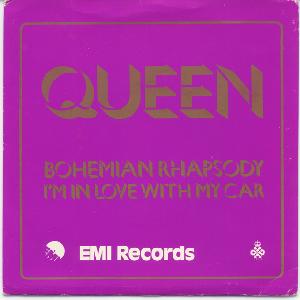 (Front Sleeve) |
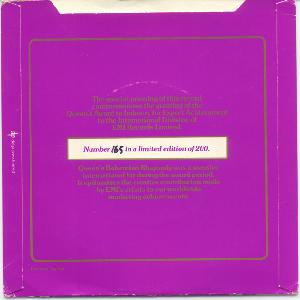 (Back Sleeve) |
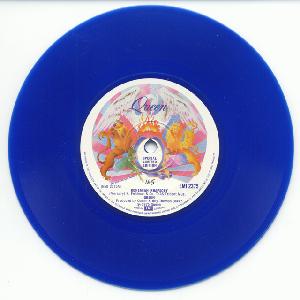 (Numbered Version) |
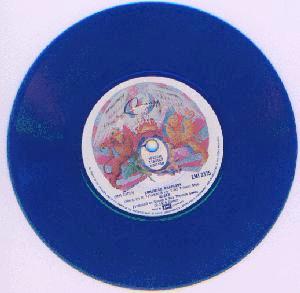 (Un-numbered Version) |
Collectors
tips:
Over the years, there have been many rumours surrounding the rare
blue vinyl edition of "Bohemian Rhapsody". Ironically,
in light of Paul Watts' recollections many fans have been under
the impression that the single exists on purple vinyl as well as
blue-albeit without a picture sleeve and the "A Night At The
Opera" crest label. If this edition does exist, then it's most
likely an overseas issue (read: a bootleg!). But whatever its origin,
it has nothing to do with the Queen's 1978 Award To Industry For
Export Achievement.
Fans forking out four-figure sums for original U.K. copies should
make sure they are paying for the genuine article.
The blue vinyl has been counterfeited and the apparent tell-tale
signs lie in the vinyl itself.
The original is pressed in a translucent royal blue colour, while
fakes are of a deeper, duller hue. The number on the back sleeve
should be handwritten (as on the A-side of the label); typewritten
numbers are counterfeits.
It is possible to read the handwritten number only on one side of
the disc. If it is present in the A-Side, then the B-Side misses
it. If it is present in the B-Side then the A-Side misses it.
It is important to say that also unnumbered records are circulating
in the collectors-circuit. That's because some of the copies produced
in that time have never been handnumbered and have been given away
as gift mainly to EMI employers but also to normal Queen fans/collectors
that wrote to EMI to ask for this item. By the way... that's why
one of my friends has 3 of these records!
There are in all 3 editions of this item:
1. The official edition that is numbered to 200 units
2. The unnumbered edition with the words "SPECIAL LIMITED EDITION"
in the center of the label
3. The unnumbered edition WITHOUT the words "SPECIAL LIMITED
EDITION" in the center of the label
Sometimes the words "SPECIAL LIMITED EDITION" may result
punched/damaged, since they are in the center of the label where
we find the hole for the record player. Why some records don't have
the words "SPECIAL LIMITED EDITION" punched off? That's
because the label has a diameter of 3,53 inches only and mycro-movements
of the label during the realization of the item could generate this
problem. That, however, doesn't afflict the value of the item!
(Close-Up of the unnumbered edition, look at the center!)
How to recognize the true item from
the fake one:
The original record has the word 'Blair' in the run out groove.
It is very slight but it is there. The bootlegs have not this word,
so when you are looking a Royal Blue Bohemian Rhapsody in your hands
look at this word to confirm that the item is genuine!
The story about this rarity:
On Wednesday 26th July 1978, a special dinner was held at the Selfridge Hotel in London to commemorate the fact that The International Division of EMI Records Ltd had been awarded the prestigious "Queen's Award To Industry For Export Achievement".
As Queen were a significant contributor to EMI's
export sales (and as a play-on-words with the "Queen's
Award"), it was decided to manufacture a special limited edition
of the "Bohemian Rhapsody" single to mark the occasion. The single
was pressed in a translucent royal blue vinyl, with a special purple
and gold sleeve. A limited run of 200 was pressed, and each record
and sleeve was numbered by hand (on the one only of the two sides
label and the back of the sleeve).
Just for the sake of the curiosity, the item was intentionally conceived
to be released in PURPLE vinyl (that's why the sleeve is purple
too!) but the miscelation of the granules to used to colouring the
vinyl went wrong!
Paul Watts, then General Manager of EMI's International Division,
explained this episode in a Record Collector article published on
June 1993 (#166). The following text, reports what he sayd:
<<We came up with the band's original colours-purple and gold,
as on the 'Queen I' cover," Watts remembers. "These colours
signified Queen in a way. We decided upon a maroon and gold sleeve-and
a single in purple vinyl." Purple vinyl? "Yes, purple!">>
As the interest surrounding the Award grew, more and more EMI staff
became involved, and the occasion mushroomed into a corporate event,
with EMI Records Ltd, as opposed to just EMI the label, beginning
to call the shots. Well aware of how easily plans can go wrong,
Paul Watts was wary about outside involvement in his Queen project:
"I was told, 'Don't you worry yourself, we'll take this over.
This is corporate stuff now'." Reluctantly, Watts agreed to
let the team upstairs design the record. "We wanted it to be
special so there would only be 200 copies," he remembers. "And
I said, 'Just make sure you do it right!'."
But as Watts had feared, the unexpected happened. "Lo and behold,"
he says, "when the record came back from the factory, it wasn't
purple at all, but blue! 'Do me a favour!' I said. But all they
could say was, 'Hmm, looks alright to me.' But it was a cockup.
The blue vinyl was a cock-up! And as we only had 200, it wasn't
worth changing it."
Down at EMI's pressing plant in Hayes Middlesex, production controller
John Tagg had no idea that the commemorative issue of "Bohemian
Rhapsody" should have been purple. Acting on those corporate
directives, he went ahead and ordered the required colour- blue.
"We made a number of records in various colours, but they were
all run of the mill stuff," he remembers. "The blue granules
were specially formulated for this project."
This special single was distributed to the EMI bosses, captains of industry and journalists who were present at the dinner. In fact, a large variety of commemorative freebies were distributed to the assembled throng, including:
- A wine glass, engraved with the "Queen's Award" logo. Some of the glasses were in a white silk-lined box.
- A pale blue silk scarf, embroidered with the "Queen's Award" logo. Some of the scarves were in a passport style folder. (Dark blue non-silk scarves have also been seen, though it is not known for certain whether these are connected with the dinner)
- A book of matches, with the "Queen's Award" logo
- A pen, presumably also with the same logo.
A special "EMI Records International Division" outer-envelope was also manufactured. Roughly A4 in size and shaped to resemble a carrier bag, there is some uncertainty what this was for. One EMI insider claimed that a regular black vinyl "Bohemian Rhapsody" was put inside it and it was given to music journalists not attending the dinner. However, the combination mentioned has never been seen, which makes it seem unlikely. The outer-envelopes that have been seen have contained proper sleeved blue vinyls, which makes it seem likely it was simply another freebie given away at the dinner. Whatever it was, there seem to have been very few of them made.
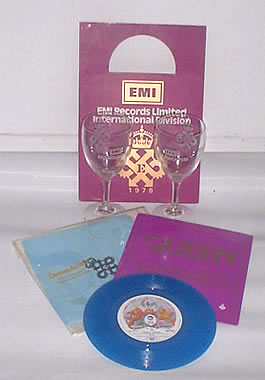
(The full set - Picture 1)
All the freebies seem to be much rarer than the blue vinyl records themselves. However, this is probably because they have become separated over the years. None of them mention Queen in any way, so someone selling their blue vinyl in the 1980s may not have thought the buyer would have been interested in a seemingly unrelated item. It is only in recent years that the full set of items has become desirable.
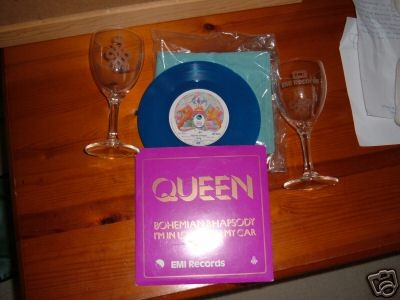
(The full set - Picture 2)
Over the years, the "blue vinyl" has become the top-of-the-league item in any list of Queen collectables. The full monty (comprising numbered vinyl, sleeve, outer envelope, glass, scarf, matches, pen, invitation, ticket and menu) would be worth a King's ransom. Even an unnumbered vinyl with no sleeve would be a worthwhile addition to anyone's collection.
Issue 167 of Record Collector had a special feature
on the blue vinyl, with someone from EMI describing how carefully
the records were manufactured and how absolutely no excess copies
were manufactured. The latter claim was proved untrue, though, as
many fans reported how they wrote to EMI in late 1978 asking for
copies of the single and received unnumbered sleeveless copies in
return. There was also a competition in the Spring 1979 fan club
magazine where two copies (believed to be unnumbered) were given
away as prizes. The former claim may also be slightly untrue, as
there is at least one case of a record numbered on the b-side and
at least one case of a record which was misnumbered and corrected.
Value over the years:
Over the last ten years, the value of a B.V. has gone up and up and up. While some of this was undoubtedly due to hype, the current high values are holding firm and even, for a copy with all the trimmings, still going up. Many of the following valuations have been taken from old copies of Record Collector magazine and are merely indicative of the actual value of an item like this.
| Date | Variation | Value |
|---|---|---|
| up to 1984 | numbered with sleeve | approx £50 |
| early 1987 | numbered with sleeve | approx £100 |
| February 1988 (RC102) | numbered with sleeve | £210 |
| October 1988 (RC110) | numbered with sleeve | £210 |
| 1990 | numbered with sleeve | approx £400 |
| 1992 | numbered with sleeve | approx £750 |
| July 1993 (RC167) | unnumbered
without sleeve numbered with sleeve numbered with sleeve and envelope the full monty |
£300 £1000 £1200 £1500 |
| January 1996 (RCRRPG) | numbered
with sleeve numbered with sleeve and envelope the full monty |
£1200 £1500 £2500 |
| January 1998 (RC221) | unnumbered
without sleeve numbered with sleeve numbered with sleeve and envelope the full monty |
£500 £2000 £2500 £3500 |
| January 2005 (eBay) | unnumbered without sleeve | £720 |
Record Collector December 1998 article:
Queen's "Bohemian Rhapsody" was recorded in the summer
of 1975 during sessions for their fourth album, "A Night
At The Opera". The song's composer, Freddie Mercury, never
revealed his inspiration for his lyrics except to say that they
were personal, about relationships.
"It's one of those songs which has such a fantasy feel about
it," he said in 1976. "I think that people should just
listen to it, think about it and then make up their own minds
as to what it says to them". According to Brian May, the
song was "really Freddie's baby from the beginning",
but the task of realizing his ideas fell to Queen's producer at
the time, Roy Thomas Baker.
"Freddie was sitting in his apartment and had an idea for the song", remembered Baker. "He didn't have it all quite worked out, but the basic framework was there. Then he stopped and said, 'Now dears this is where the opera section come in!' And I thought, 'Oh God!'" The over-the-top operatic reverie that is the song's middle section was originally intended only as a brief interlude, but once recording began, "Bohemian Rhapsody" took on a life of its own.
Roy Thomas Baker would arrive at the studio each day, assuming that the song was finished. And then Freddie would arrive: "He'd walk in and say, 'We'll just stick some more 'Galileos' in here'! It got longer and longer, and we kept adding blank tape...!" Sessions for the song eventually stretched to nearly three weeks, with the opera section alone taking seven days to complete. The trio of Mercury, May and Roger Taylor sang their parts continually for ten to twelve hours a day, resulting in an astonishing 180 separate overdubs. Although detractors accused Queen of being pretentious, the atmosphere in the studio was the exact opposite - the group were in constant hysterics at the overt campness of the song.
The group were justifiably proud of the finished product, and wanted it released as their next single. However, at nearly six minutes in length, both EMI and Queen's manager, John Reid, were reluctant, maintaining that the radio stations wouldn't play it. A subtle editing job was proposed, but Queen were adamant that the song should be heard in its entirety.
Freddie himself had some doubts as to its potential as a hit single, and sought the advice of his friend, DJ Kenny Everett, sending him a promo copy accompanied by strict instructions not to broadcast it. Kenny knew it was a hit "from the first note", and disobediently played it a reported fourteen times on his two weekend shows on Capital Radio, claiming that "his finger slipped"! EMI was swamped with inquires the following Monday and realized they were onto something big.
Released on October 31st 1975, "Bo Rhap" entered the charts the following week at No. 47, climbing to No. 1 three weeks later, where it stayed for an incredible nine weeks, helped by a memorable innovative prop video.
Three years later, Queen had gone from strength to strength, creating stadium anthems such as "We Are The Champions" and "We will Rock You", but it was "Bo Rhap" that was remembered when EMI was awarded the prestigious Queen's Award To Industry For Export Achievement. Beating off competition from thousands of other manufactures, EMI's International Division won the title due to the massive increase in exports of records by British artists.
As EMI's International Sales Manager at the time, Norman Bates, explained: "The award was for EMI's records and pressing fees, with some importance to Queen, who were getting bigger and bigger at the time. What it meant was that groups like Queen were being shipped to markets throughout the world where there were no manufacturing facilities. So from Iceland to Zanzibar we were selling records where previously we hadn't." After compiling a portfolio for the Department Of Trade And Industry, detailing the increase in turnovers, EMI became Her Majesty's choice for 1978. "It really was a coveted award," Bates recalled. "We were over the moon to receive it."
Justifiably proud, Paul Watts, then General Manager of EMI's International Division, decided to commemorate the award with the release of a special single. The choice of artist was easy. "The award represented the way in which Queen were so much a part o the fabric of the company," he recalled. "They were central to what EMI was doing." "Bohemian Rhapsody" seemed the natural choice for the record, as it was such a milestone and had been the single that had catapulted Queen into international super stardom.
The then current vogue for colored vinyl seemed to the the ideal way to present this special edition of 200 copies: "We came up with the band's original colors - purple and gold, as on the 'Queen I' cover," Watts remembered. "These colors signified Queen in a way. We decided on a maroon and gold sleeve and a single in purple vinyl." But it wasn't to be: the project became a corporate event, with EMI Records Ltd (and not just EMI the label) getting in on the action. Paul Watt reluctantly relinquished control of the project to "the team upstairs", imploring them to "make sure you do it right!"
But as Watts had feared, there was a blunder: "Lo and behold, when the record came back from the factory, it wasn't purple at all, but blue! It was a cock-up, but as we only had 200, it wasn't worth changing it." At the EMI pressing plant in Hayes, Middlesex, Production Controller John Tagg had no idea that the vinyl should have been purple, and - acting on corporate directives - pressed the record in blue. "The blue granules were specially formulated for the project," he remembered.
Pressing the run of 200 blue vinyl singles from the usual minimum of 1,000 or 1,500 black vinyl records was no easy feat, with Tagg and his team having to isolate the special edition from the rest of their system. Getting a pure blue strain of vinyl was also time-consuming, and the Queen single took around three days to produce, costing an exorbitant £4 to £5 per copy, where the usual rate was 50p. To finish off the record, full-colour "Night At The Opera" crest labels were printed and each disc was hand numbered on the A-side and again on the back of the special purple-and-gold sleeve.
Although John Tagg claims that the record was "very much a limited edition" of only 200 and that all the materials associated with the pressing were destroyed afterwards, some unnumbered test pressings or end-of-run copies did slip out. These come with finished labels but no sleeves, and are currently worth around £500-£600.
EMI's International Division was formally presented with the Queen's Award To Industry for Export Achievement at a three-hour luncheon in the Cotswold suite at London's Sellfridge Hotel on Wednesday, 26th July 1978. EMI directors and management were out in force, but Her Majesty was absent, sending instead the Vice Lord-Lieutenant Of Greater London, Admiral Sir Charles Madden as her representative. the group themselves were also noticeably absent, being holed up in Montreux, Switzerland, recording the "Jazz" album and holding a typically extravagant party for Roger Taylor's 29th birthday (most probably attended by naked women on bicycles).
The initial quantity of blue vinyl singles was framed and given to the members of Queen's entourage and EMI big cheeses. Press kits were packaged in an 'EMI International Division' purple carrying envelope (complete with card handles) and sent out with luncheon invitations. The remaining copies were handed out to the luncheon guests, along with a pair of etched goblets in a blue silk-lined box and a blue silk scarf, both bearing the official award's 'E' export logo. Some sets also came with a commemorative brio.
Despite
the pomp and circumstance of the occasion, EMI's Norman Bates remembered
that the record giveaway was a bit of a mundane affair: "They
were just shoved in a plastic bag and handed out. You didn't really
know what you had until you got back to the office. Most people
got either the record, or the glasses and the scarf. But I managed
to get all three!"
Curiosity:
My friend Debbie Breslaw is selling her copy number 132 of the Royal
Blue Bohemian Rhapsody in picture sleeve. She put this item on eBay
(LINK)
and the following is the story of this item #132:
The
sister of Debbie is called Caoline Franks and she worked for EMI
in the public relations department from 1975 to 1982.
She was given the record by the publicity co-ordinator. She never
played it since she put it in a single record cas at the top of
a cupboard...
On
January 2005, the English BBC3 TV broadcasted (or better... re-broadcasted)
the Making of Bohemian Rhapsody TV Special, then she saw the disc
and the sleeve being held up and heard that it was worth a lot of
money.
She thought to herself: "I'm sure I have got one of those!"
She went to her cupboard and opened the box since she find it at
the top of it. Follow some pictures
of the #132, you will see that the number is handwritten in the
B-Side label and not in the A-Side, this should be helpful to others
who have always told that the number is handwritten on the A-Side
only, that's not true at all!
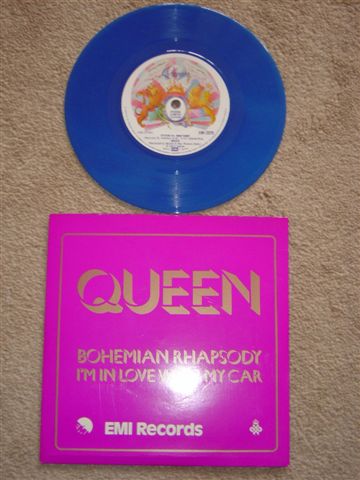 (Front Sleeve) |
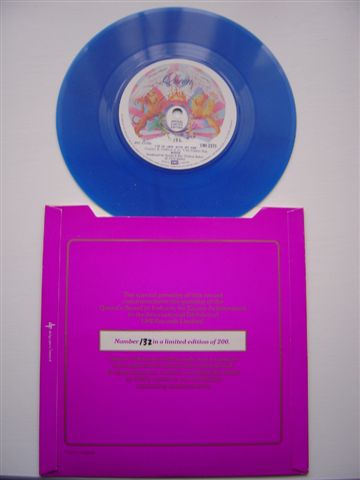 (Back Sleeve) |
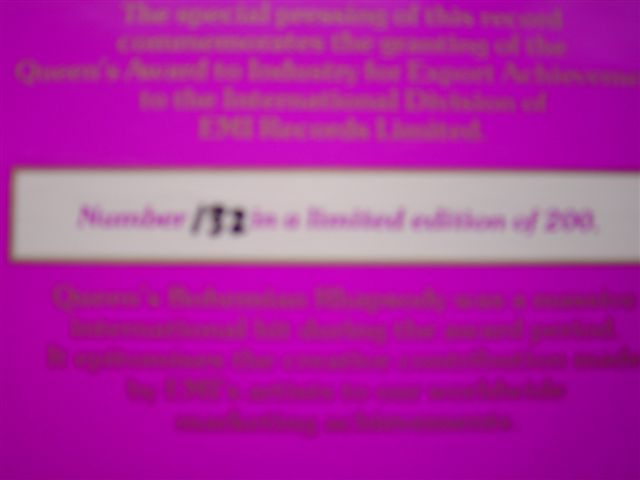 (Number in the back of the sleeve) |
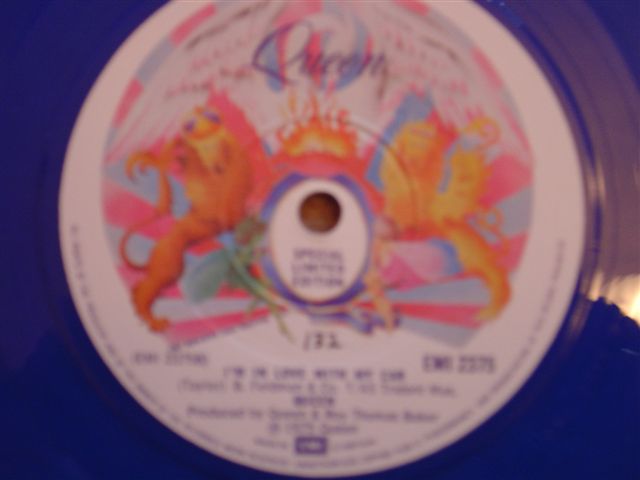 (Close-Up of the numbered B-Side) |
Always link to a http://www.queencollector.net
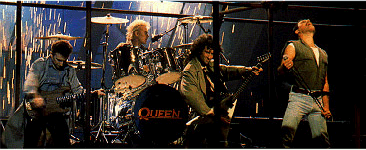
© QueenCollector.net - Queen Fan Page 2005 - This page was last updated on 10/02/05 . |
